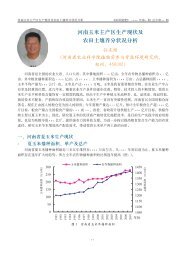Better Crops 2004 #2 - International Plant Nutrition Institute
Better Crops 2004 #2 - International Plant Nutrition Institute
Better Crops 2004 #2 - International Plant Nutrition Institute
Create successful ePaper yourself
Turn your PDF publications into a flip-book with our unique Google optimized e-Paper software.
<strong>International</strong> Section<br />
Site-Specific Nutrient Management<br />
for Optimal Foodgrain Production<br />
in Haryana<br />
By K.S. Yadav and Hira Nand<br />
Cropping systems governed by either generalized state soil testing recommendation<br />
systems or common farmer practice are incapable of maximum<br />
economic yield. In this study, it is evident that inadequate nutrient<br />
use is severly limiting pearl millet and pigeonpea production in Haryana<br />
State.<br />
I N D I A<br />
Afive-fold increase in foodgrain production in Haryana State during<br />
the last 35 years combined with inadequate and unbalanced<br />
nutrient supply has led to continued and accelerated soil nutrient<br />
depletion of all essential plant nutrients. Farmers in Haryana apply generalized<br />
quantities of nitrogen (N), phosphorus (P), and zinc (Zn) in<br />
foodgrain crops, and as a consequence, deficiencies of P, potassium (K),<br />
sulfur (S), iron (Fe), manganese (Mn), and copper (Cu), and boron (B) are<br />
increasing. Deficiencies of S and Fe have become especially widespread<br />
during the last decade in fields growing pearl millet, sugarcane, wheat,<br />
and legumes. The desire for sustained productivity in these important<br />
soils places an urgent need to arrest this trend.<br />
Pearl millet and pigeonpea crops presently occupy<br />
586,000 ha and 16,000 ha, respectively, in<br />
Haryana, and corresponding productivity for these<br />
two crops is quite low at 1.42 t/ha and 0.81 t/ha.<br />
Opportunity for improvement exists through better<br />
nutrient management coupled with other best<br />
management practices. A research project was initiated<br />
to study the effect of site-specific nutrient<br />
management (SSNM) on crop yield and profit while<br />
demonstrating the drawbacks of relying on common<br />
farmer practice or even state fertilizer recommendations.<br />
Field experiments were conducted during 2001-<br />
02 in farmers’ fields in the village of Tikli in Gurgaon District. Soils were<br />
sandy loam, alkaline in reaction, low in organic matter, with cation<br />
exchange capacities varying between 10 to 12 cmol (+)<br />
/kg. Soils were<br />
generally deficient in available N, P, K, S, Zn, Fe, and Mn. Pigeonpea var.<br />
UPAS-120 was sown in the last week of June while pearl millet hybrid<br />
Site-specific nutrient<br />
management (SSNM) can<br />
increase productivity of<br />
pigeonpea.<br />
<strong>Better</strong> <strong>Crops</strong>/Vol. 88 (<strong>2004</strong>, No. 2) 21

















